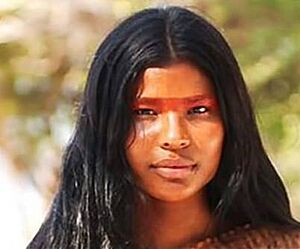Gran Pajonal facts for kids
Quick facts for kids Gran Pajonal |
|
|---|---|
| Geography | |
| Location | Ucayali Department, Pasco Department, Junín Department, Peru |
| Range coordinates | 10°45′14″S 74°13′12″W / 10.754°S 74.220°W |
The Gran Pajonal (which means Great Scrubland or Great Savanna) is a special high land area in the Amazon Basin of Peru. It's like a big, flat-topped mountain that stands alone. You can find it in the regions of Ucayali, Pasco, and Junín.
This unique place is home to the Asháninka people. Later, in the 1900s, other people from the Andes mountains of Peru also moved here. In the 1730s, Roman Catholic Franciscan missionaries tried to set up churches and communities in the Gran Pajonal. But in the 1740s, the Asháninka, led by Juan Santos Atahualpa, bravely fought back and destroyed these missions.
Around 1897, more missionaries, rubber collectors, and settlers started coming to the Gran Pajonal. The Peruvian government also became more involved. By the 1980s, the Asháninka people gained more control over their land. Most of the Gran Pajonal was officially given to 36 of their communities. In 2002, about 7,000 people lived in the Gran Pajonal. A huge 90 percent of them were Asháninka.
Contents
What is the Gran Pajonal Like?
The Gran Pajonal is a large plateau, which is a high, flat area of land. Its size is usually described as being between 2,000 and 4,000 square kilometers (about 770 to 1,540 square miles). People sometimes use the name "Gran Pajonal" to talk about an even bigger area around it.
The land here is between 900 meters (about 2,950 feet) and 1,400 meters (about 4,600 feet) high. Many small rivers start in this area, cutting through the land.
Why is it Called Gran Pajonal?
The Spanish named it Gran Pajonal because it has patches of small grasslands. This is unusual for a tropical rain forest area. These grasslands make up about 4 percent of the total land.
The Gran Pajonal doesn't have clear borders. It lies east of the Cerro de la Sal (Salt Mountain) area. It's like an outpost of the Andes mountains. To its west is the Palcazu River, and to its east is the Ucayali River. The Perene and Tambo rivers border it to the south. The El Sira Communal Reserve and mountains are to the north. The Cerro de la Sal mountain range also marks its southern edge. Mountains around the plateau can be taller than 1,800 meters (about 5,900 feet).
Weather and Nature in Gran Pajonal
Because the Gran Pajonal is high up, it's cooler than the lowlands of the Amazon. The average temperature is usually between 21°C (70°F) and 23°C (73°F). It rains a lot, with more than 2,100 millimeters (about 83 inches) of rain each year. There is a drier period from June to August.
Most of the land is tropical rain forest. But there are also grasslands, which cover about 9,700 hectares (about 24,000 acres). These grasslands were created over hundreds or thousands of years by the local people farming the land. By 2004, another 3,500 hectares (about 8,600 acres) of grasslands had been made since 1975. These new areas were used for animals and were created by people who moved there, mostly farmers from the Andes.
History of the Gran Pajonal
The native people living in the Gran Pajonal when the Spanish first arrived were called Campa, Anti, or Chuncho. Today, they are known as Asháninka or Ashéninka. They are a large group of people living in the Amazon Basin of Peru and Brazil. The Asháninka of the Gran Pajonal are sometimes called Ashéninka because their language is a bit different.
Asháninka Way of Life
Like most people in the Amazon rainforest, the Asháninka used a farming method called slash-and-burn. This means they would cut down and burn small areas of forest to clear land for crops. Their main crop was manioc (also called yuca). They also grew bananas, peanuts, beans, and many other useful plants. An Asháninka farmer might grow as many as 50 different types of plants on their farm!
Early European Contact
The Gran Pajonal was hard to reach because it was high up and didn't have big rivers for boats. The first Spaniard to visit was Juan Bautista de la Marca, a Franciscan missionary, in 1733. Missionaries and settlers liked the area right away. It had many native people and a nicer climate than the hot Amazon lowlands.
In 1735, an armed group with three Franciscans started missionary work. By 1739, Franciscans were working in 10 villages. The Spanish often tried to make native people live in large communities near the missions. This was different from the Asháninka custom of living in smaller, spread-out groups.
The Asháninka Fight for Freedom
In 1742, a rebellion led by Juan Santos Atahualpa began. This uprising destroyed the missions. The Asháninka kept control of the Gran Pajonal for 150 years. However, they did suffer from diseases brought by Europeans. In the late 1800s, some people were taken away by businesses collecting rubber.
In 1896 and 1897, a Franciscan priest named Gabriel Sala visited the Gran Pajonal with armed men. After his trip, there were plans to build roads, railroads, and new Catholic missions. But these plans didn't work out until 1935, when three missions were finally set up. In 1938, an airstrip was built in Oventeni, which was the biggest mission community.
In 1965, the Peruvian army fought a group called the Left Revolutionary Movement in the Pajonal. The army stayed in Oventeni for three years, and the missions were closed.
New Beginnings and Land Rights
Also in 1965, another religious group called the Wycliffe Translators started working in the Pajonal. Most missionaries there became Protestants instead of Roman Catholics. At the same time, the Asháninka people realized they needed to organize to protect themselves from outsiders.
In the 1980s, with help from the World Bank and Denmark, the Asháninka achieved an important victory. They gained legal ownership of the land for 36 communities in the Gran Pajonal. People who were not Asháninka, mostly from the Andes, were only allowed to live and own land in the community of Oventeni. Some Asháninka worked for outsiders, taking care of cattle or harvesting coffee. Others continued their traditional farming on their community lands.
Gran Pajonal's Location and People
The Gran Pajonal stretches across parts of three different regions in Peru. It includes:
- Raimondi District in the Atalaya Province of Ucayali Department
- Puerto Bermúdez District in the Oxapampa Province of Pasco Department
- A small part of Rio Tambo District of Satipo Province in Junín Department
At the very center of the Gran Pajonal is the community of Oventeni. It is about 1,003 meters (about 3,290 feet) high. All around Oventeni are the patches of grassland that gave the Gran Pajonal its name. In 2002, the 36 Asháninka communities had about 6,500 people. The non-Asháninka people living there numbered about 650.
See also
In Spanish: Gran Pajonal para niños



